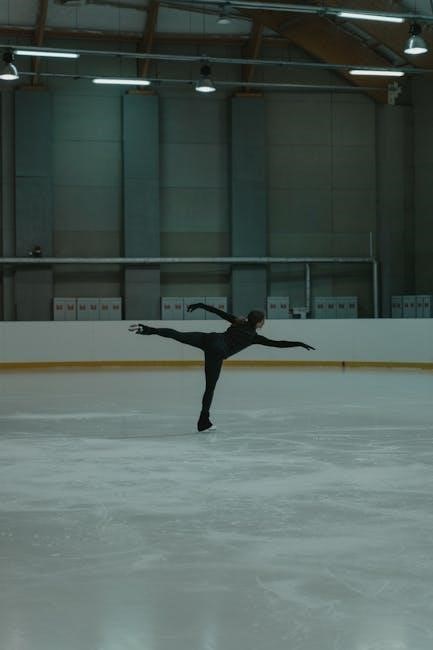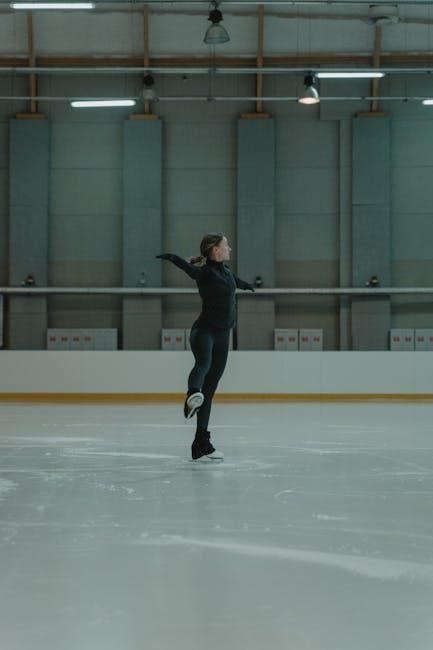
Trochanteric bursitis, often linked to inflammation of the bursa near the hip’s greater trochanter, causes pain and limited mobility. Exercise rehabilitation focuses on stretching and strengthening the hip muscles to reduce symptoms and improve function.
Understanding Trochanteric Bursitis
Trochanteric bursitis is an inflammatory condition affecting the bursa located near the greater trochanter, the bony prominence on the outer aspect of the hip. This bursa cushions the hip joint and reduces friction between soft tissues and bones. Inflammation occurs due to repetitive motion, prolonged pressure, or direct trauma, leading to pain and discomfort on the outer hip. Symptoms often include tenderness, swelling, and difficulty sleeping on the affected side. It is sometimes referred to as greater trochanteric pain syndrome, as the pain may involve multiple structures around the hip. The condition is more common in middle-aged women and individuals with repetitive hip movements, such as athletes or those with poor posture. Early diagnosis and treatment, including physical therapy and targeted exercises, are crucial to managing symptoms and restoring hip function. Understanding the condition is the first step toward effective rehabilitation and long-term recovery.

Stretching Exercises for Trochanteric Bursitis
Stretching exercises are essential for improving hip flexibility and reducing muscle tightness, which can contribute to trochanteric bursitis symptoms. Regular stretching of the piriformis and gluteal muscles helps alleviate pain and inflammation. Consistency is key.
Piriformis Stretch
The piriformis stretch is a cornerstone exercise for managing trochanteric bursitis. To perform this stretch, lie on your back with both knees bent. Place the ankle of the affected leg over the knee of the unaffected leg. Gently pull the unaffected thigh toward your chest until a mild stretch is felt in the buttock of the affected side. Hold this position for 20-30 seconds and repeat 2-3 times on each side. This stretch targets the piriformis muscle, which runs close to the inflamed bursa, helping to reduce tightness and discomfort. Regular performance of this stretch can significantly improve hip mobility and alleviate bursitis-related pain. It’s recommended to do this exercise daily, ideally after a warm-up or light activity to enhance effectiveness. Consistency is crucial for long-term relief and prevention of symptom recurrence.
Gluteal Stretch
The gluteal stretch is an essential exercise for addressing trochanteric bursitis. To perform this stretch, lie on your back with both knees bent. Place the ankle of the injured leg over the knee of the good leg. Grasp the thigh of the good leg with your hands and gently pull it toward your chest until you feel a mild stretch in the buttock of the injured side. Hold this position for 20-30 seconds and repeat 2-3 times daily. This stretch helps to relax the gluteal muscles, which are often tight in individuals with trochanteric bursitis. Regular performance can improve hip flexibility and reduce discomfort. It’s important to maintain proper form to avoid putting unnecessary strain on the hip joint. Consistency with this stretch, along with other recommended exercises, can lead to significant symptom relief and improved mobility over time. Always consult a healthcare professional before starting any new exercise program.
The isometric gluteus medius stretch is a beneficial exercise for individuals with trochanteric bursitis, targeting the muscle responsible for hip stability. To perform this exercise, lie on your side with the injured leg on top. Bend both knees to approximately 60 degrees, ensuring the heels remain together. Slowly lift the top knee upward without moving the hips, maintaining the position for 5-10 seconds. Repeat this motion 10-15 times, resting briefly between repetitions. This stretch strengthens the gluteus medius muscle without putting excessive strain on the hip joint, making it ideal for early stages of rehabilitation. Consistency with this exercise can enhance hip stability and reduce pain associated with trochanteric bursitis. It’s important to focus on controlled movements and avoid compensating with other muscle groups. Over time, incorporating this stretch into a daily routine can lead to improved hip function and reduced inflammation. Always consider consulting a physical therapist to ensure proper form and progression. Strengthening exercises are crucial for managing trochanteric bursitis, targeting the gluteus medius and other hip muscles. They improve hip stability, reduce pain, and enhance functional movement. Begin these exercises once sharp pain subsides. The sidelying straight leg raise is an effective exercise for strengthening the gluteus medius muscle, which supports the hip joint. To perform this exercise, lie on your side with your legs straight. Slowly lift the top leg, keeping it straight, while maintaining core stability. Hold for 3-5 seconds before lowering. Perform 3 sets of 10-15 repetitions on both sides. This exercise helps improve hip abduction and reduces pain associated with trochanteric bursitis. It is important to ensure proper form to avoid putting strain on the hip joint. Over time, this exercise can help restore strength and function, allowing for better mobility and reduced discomfort in daily activities. Consistency is key, and progress should be gradual to prevent overexertion. The clamshell exercise targets the gluteus medius muscle, which is essential for hip stability and proper gait mechanics. To perform this exercise, lie on your side with your hips and knees bent at a 90-degree angle. Place your feet touching each other. Slowly lift the top knee upward while keeping your feet together, ensuring the movement comes from the glutes and not the hips. Hold for 2-3 seconds, then gradually lower your knee back to the starting position. Perform 3 sets of 10-15 repetitions on each side. This exercise helps strengthen the hip abductors and improves pelvic alignment, reducing strain on the trochanteric bursa. It is important to maintain proper form to avoid activating the hip flexor muscles. Over time, this exercise can enhance hip stability and reduce discomfort associated with trochanteric bursitis. Consistency and gradual progression are key to achieving optimal benefits. The isometric abduction exercise is a valuable component of trochanteric bursitis rehabilitation. To perform this exercise, lie on your back with the affected leg closest to a wall. Press the foot of the affected leg against the wall and hold for 10 seconds. This movement targets the gluteus medius muscle without putting excessive strain on the hip joint. It helps improve strength and stability around the hip, reducing inflammation and pain associated with trochanteric bursitis. Perform 3 sets of 10 repetitions daily. Proper form is essential to avoid activating other muscle groups. Over time, this exercise can enhance hip function and reduce discomfort. Consistency is key to achieving long-term benefits and preventing recurrence of symptoms. This exercise is particularly effective when incorporated into a comprehensive rehabilitation program focused on strengthening and stabilizing the hip muscles. Strengthening the core and hip muscles is crucial for managing trochanteric bursitis. These exercises improve balance, stability, and reduce strain on the hip joint, aiding in recovery and preventing future inflammation. This exercise targets the gluteus medius muscle, which plays a key role in hip stability and proper gait mechanics. Lie on your side with your hips bent to 60 degrees and heels together. Slowly lift the top knee upward without allowing the hips to roll backward. Hold for 10 seconds, then lower. Perform 3 sets of 10 repetitions on the affected side, twice daily. This exercise strengthens the gluteus medius, improving hip alignment and reducing strain on the trochanteric bursa. Proper form is essential to avoid compensatory movements. Over time, this can help alleviate pain and restore normal hip function. Consistency is crucial for long-term benefits and prevention of recurrence. Ensure to progress gradually as symptoms improve. This exercise is designed to strengthen the gluteus medius muscle, which is essential for hip stability and proper movement. Lie on your side with your legs straight and toes pointed. The leg on the bottom should remain in contact with the floor. Slowly lift the top leg upward, keeping it straight, while maintaining a neutral pelvis position. Avoid letting the hips roll backward. Hold for 3-5 seconds at the top, then slowly lower your leg. Perform 3 sets of 10-15 repetitions on the affected side, twice daily. This exercise helps improve hip abduction strength and stability, reducing strain on the trochanteric bursa. Proper form is critical to avoid compensatory movements. Over time, this exercise can enhance hip function and reduce pain associated with trochanteric bursitis. Consistency and gradual progression are key to achieving long-term benefits and preventing recurrence. Consistently performing the recommended stretching and strengthening exercises is crucial for managing trochanteric bursitis and achieving long-term relief. Over time, these exercises improve hip mobility, strengthen the surrounding muscles, and reduce inflammation. As pain decreases and strength improves, gradually progress to more challenging exercises, such as dynamic movements or resistance training. Aim to incorporate core and hip stability work to enhance overall lower extremity function. It is essential to avoid activities that aggravate symptoms during the rehabilitation process. With patience and adherence to the exercise program, most individuals experience significant improvement within 4-6 weeks. Always consult with a healthcare provider or physical therapist before starting or advancing any exercise regimen to ensure proper form and safety. By combining exercise with activity modification, individuals can effectively manage trochanteric bursitis and reduce the risk of recurrence.Isometric Gluteus Medius Stretch

Strengthening Exercises for Trochanteric Bursitis
Sidelying Straight Leg Raise
Clamshell Exercise
Isometric Abduction Exercise

Core and Hip Stability Exercises
Gluteus Medius Stability Exercise

sidelying straight leg raise